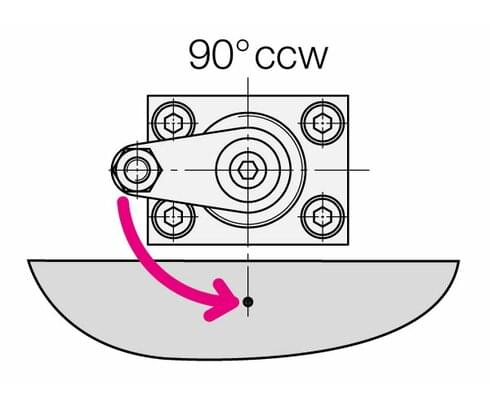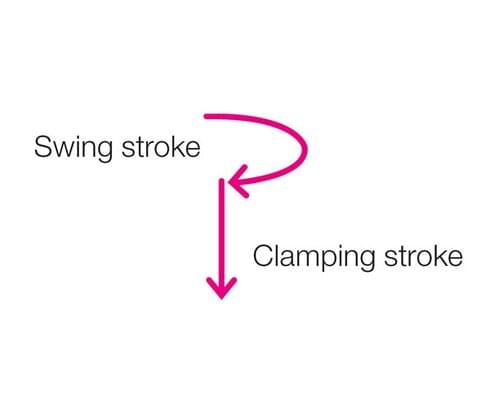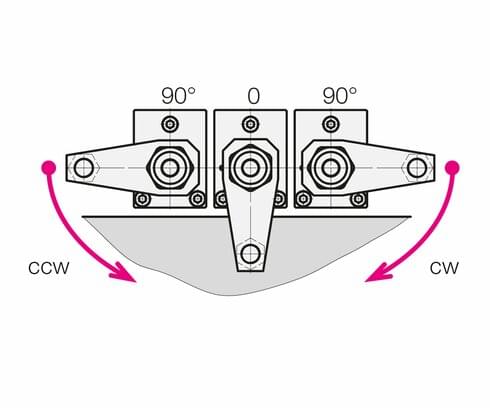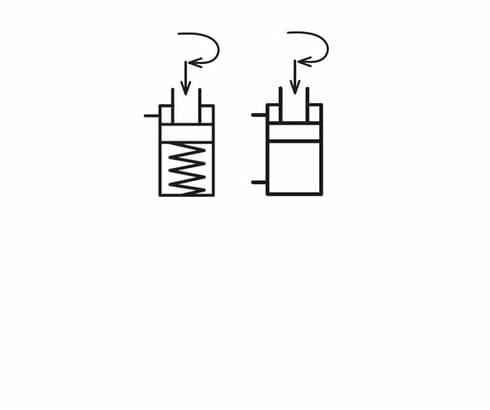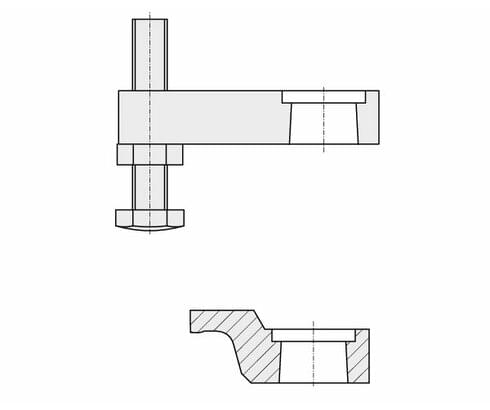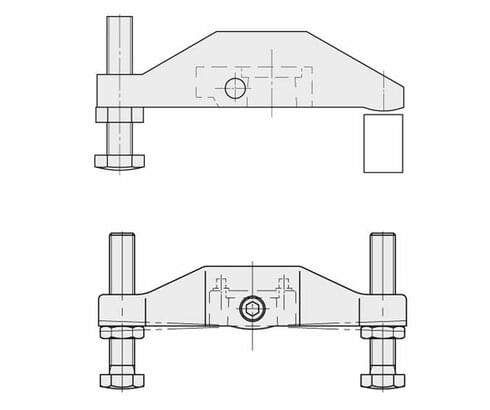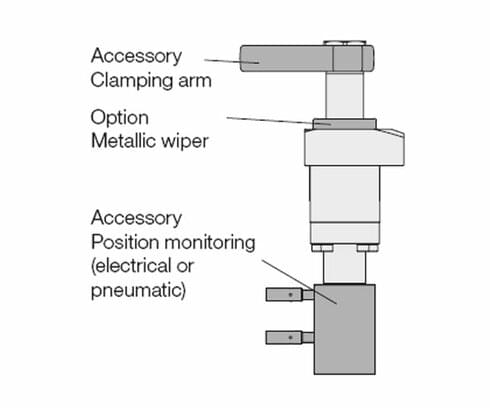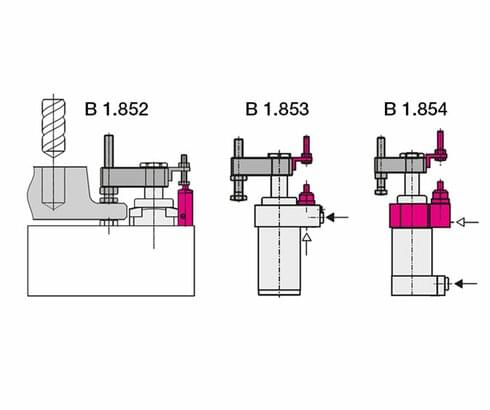Swing clamps (24)
Application
Hydraulic swing clamps are used for clamping of workpieces when it is essential to keep the clamping area free of straps and clamping components for unrestricted workpiece loading and unloading.
Function
A swing clamp is a pull-type cylinder where a part of the total stroke is used to swing the piston (swing stroke) and the screwed-on clamping arm.
Some versions also swivel without an axial swivel stroke (see series B1.8806).
Swing direction
The swing clamps are available with clockwise and counterclockwise swing motion or without swing motion (0°). "Swing direction cw" designates the clockwise rotation of the piston starting from the extended position (off-position). Accordingly, the "swing direction ccw" is a counterclockwise rotation.
Standard swing angles
are 90°, 60° and 45°
Special angles on request.
0° version
Use as pure pull-type cylinder with a piston which is secured against torsion and which
allows eccentric load as per clamping force diagram.
Tolerance of the swing angle
is ±2°, if not otherwise indicated. For swing clamps with reinforced swing mechanism the
tolerance is ±1°.
Single or double acting
Single-acting swing clamps retract to the off-position with spring force.
Advantages: simple valve control and only one supply line
Double-acting swing clamps retract with hydraulic pressure
Advantages: short calculable unclamping times and higher process safety in automatic mode
Accessory – Clamping arm
As accessories different clamping arms are available.
Material 42CrMo4
- One-sided clamping arm with contact bolt
- One-sided short, cranked clamping arm
- Clamping arm assembly
The design of the clamping arm assembly is asymmetric. The bearing pin is mounted on the side of the carrier. Thereby an asymmetric lever ratio is generated that provides a higher clamping force. The second support point of the clamping arm assembly on the right is not used for clamping but only for support.
- Double clamping arm
The double clamping arm is designed symmetrically. A carrier provides the connection to the piston. Thereby 2 workpieces can be clamped at the same time, the pulling force of the piston is reduced by half. Two pressure springs keep the clamping arm in
horizontal position.
Clamping arm seat
To locate clamping arms or clamping arm assemblies, normally a cone seat at the piston of
the swing clamp is used. The cone ratio is 1 to 10. This location is the same for all types of one size.
Clamping arm mounting
When tightening and untightening the fixing screw, the clamping arm has to be backed up
to avoid the introduction of moments to the piston rod and thereby any deterioration of the
swing mechanism.
Adjustment of contact bolt
The contact bolt may only contact the workpiece after completion of the swing motion.
When tightening and untightening the lock nut, the clamping arm has to be backed up.
Accessory – Position monitoring
Position monitoring is available as an accessory for some swing clamp types.
The positions "Unclamped" and "Clamped" are acknowledged.
Position monitoring is operated by an "extended rod". This rod protrudes at the bottom of the swing clamp and is hydraulically sealed. It forms one unit together with the helix rod and allows a pneumatic or electrical monitoring of the piston position outside the swarf area. With the pneumatic position monitoring the positions can be controlled by pressure switches or differential pressure switches. In the case of electrical position monitorings the controls are effected by inductive proximity switches.
An alternative control are the pneumatic position monitorings as per data sheet B 1.852,
B 1.853 and B 1.854. The position "Clamped" is directly controlled at the clamping arm.
Option – Metallic wiper
In addition to the FKM wiper many double-acting swing clamps can be equipped with a metallic wiper. The metallic wiper protects the FKM wiper against mechanical damage, e. g. by hot swarf or high coolant pressure. The metallic wiper is not suitable for dry machining, minimum quantity lubrication and in case of accumulation of very small grinding swarf.
Materials
Piston material: high alloy steel, nitrated or chromium-plated
Body material: high alloy steel, nitrated
By nitrating piston and body, wear is reduced and protection against corrosion increased.
Sealing materials
Series:
• NBR = nitrile butadiene rubber
Trade name e.g.: Perbunan
Operating temperature: – 30 up to + 80 °C
On request:
• FKM = flouro rubber
Trade name e.g.: VITON®
Operating temperature: – 20 up to + 150 °C
Maximum operating pressure
For one-sided clamping arms the maximum admissible operating pressure depends on the
length of the clamping arm. These values are indicated in the diagrams on the corresponding data sheets. When using a double clamping arm or a clamping arm assembly, the complete operating pressure can be applied.
Admissible flow rate
The admissible flow rate has to be kept to avoid overload, increased wear and malfunctions of the swing clamp. Throttling has to be made in the oil supply line to the swing clamp to rule out a possible pressure intensification. Use only flow control valves which allow oil return from the swing clamp without any impediments.
During unclamping the admissible oil flow rate can obtain a higher value, since the piston area is correspondingly bigger.
Unimpeded swing motion
The swing motion must not be impeded and the clamping arm may only contact the workpiece after completion of the swing stroke.
Overload protection device
A preloaded coupling between piston and helix rod disengages when the overload torque is
exceeded (see technical data). This protects the swing mechanism from damage in the
event of:
- blocked swing motion
- too high swing speed
- improper fixing of clamping arm
After pressure relief, the piston can be engaged again by hand.
VI version without overload protection device
Some series can be supplied in VI version on request.
VI = V - reinforced swing mechanism + I - hexagon socket in the piston rod
Advantages
- Higher process safety in automatic mode
- Halving of the clamping and unclamping time with possible doubling of the flow rate
- Easier mounting of the clamping arm
Reinforced or sturdy swing mechanism
Some series are only available with a reinforced or sturdy swing mechanism. They are also
named in this way on the corresponding data sheets.
Advantages
- High process safety in automatic mode
- Endures a collision of the clamping arm with the workpiece up to a clamping pressure of 100 bar
- Optionally available with extended piston rod for position monitoring
Danger of injury
Hydraulic clamping elements can generate considerable forces. Due to the swing motion,
the exact clamping and unclamping position cannot be determined in advance.
Considerable injuries can be caused to fingers in the effective area of the clamping arm.
Remedy: protection device with electrical locking.
Dimension tolerances
Dimensions without tolerance data correspond to the general tolerances in accordance with
DIN ISO 2768 -mH.
Fittings
Fittings suitable for the Whitworth G pipe thread correspond to DIN 2353, screwed plug
type B or E according to DIN 3852 sheet 2 (with sealing edge or soft seal).
Important: No additional sealing materials, such as Teflon ribbon, must be used!
Leakage rate
ROEMHELD swing clamps are leakage-free in static condition. During displacement of the piston a residual lubricating film will be tolerated with regard to the life of sealings and guides. A leakage in the form of oil drops indicates a necessary replacement of wear parts.
Bleeding
Air in the oil prolongs the clamping time considerably and leads to function troubles. Therefore bleeding has to be effected during start up. Venting of the spring area of single-acting swing clamps If there is a possibility that aggressive cutting lubricants and coolants penetrate through the sintered metal air filter into the cylinder's interior, a vent hose has to be connected and be placed in a protected position.
For further notes and provisions see data sheet A 0.100.
Take advantage of the free benefits of our login area:
- CAD data download
- Download operating instructions
Welcome back! Log in to your already existing user account.
